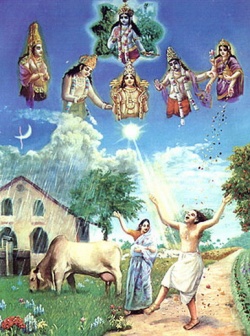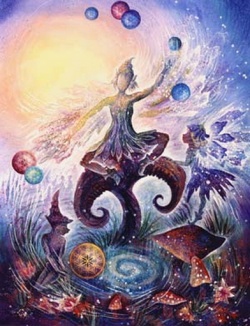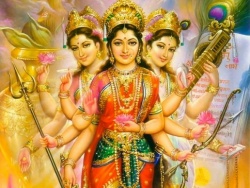Types of deva
The term deva does not refer to a natural class of beings, but is defined anthropocentric-ally to include all those beings more powerful or more blissful than humans. It includes some very different types of being; these types can be ranked hierarchically. The lowest classes of these beings are closer in their nature to human beings than to the higher classes of deva.
The devas fall into three classes depending upon which of the three dhatu's, or "realms" of the universe they are born in.
The devas of the Arupadhatu have no physical form or location, and they dwell in meditation on formless subjects. They achieve this by attaining advanced meditational levels in another life. They do not interact with the rest of the universe.
The devas of the Rupadhatu have physical forms, but are sexless and passionless. They live in a large number of "heavens" or deva-worlds that rise, layer on layer, above the earth. These can be divided into five main groups:
The Suddhavasa devas are the rebirths of Anagamins, Buddhist religious practitioners who died just short of attaining the state of Arhat (Brahma Sahampati, who appealed to the newly enlightened Buddha to teach, was an Anagami from a previous Buddha. They guard and protect Buddhism on earth, and will pass into enlightenment as Arhats when they pass away from the Suddhavasa worlds. The highest of these worlds is called Akanistha.
The Brhatphala devas remain in the tranquil state attained in the fourth dhyana.
The Śubhakrtsna devas rest in the bliss of the third dhyana.
The Abhasvara devas enjoy the delights of the second dhyana.
The Brahma devas (or simply Brahmas) participate in the more active joys of the first dhyana. They are also more interested in and involved with the world below than any of the higher devas, and sometimes intervene with advice and counsel.
Each of these groups of deva-worlds contains different grades of devas, but all of those within a single group are able to interact and communicate with each other. On the other hand, the lower groups have no direct knowledge of even the existence of the higher types of deva at all. For this reason, some of the Brahmas have become proud, imagining themselves as the creators of their own worlds and of all the worlds below them (because they came into existence before those worlds began to exist).
The devas of the Kamadhatu have physical forms similar to, but larger than, those of humans. They lead the same sort of lives that humans do, though they are longer-lived and generally more content; indeed sometimes they are immersed in pleasures. This is the realm that Mara has greatest influence over.
The higher devas of the Kamadhatu live in four heavens that float in the air, leaving them free from contact with the strife of the lower world. They are:
The Parinirmita-vasavartin devas, luxurious devas to whom Mara belongs;
The Nirmanarati devas;
The Tushita devas, among whom the future Maitreya lives;
The Yama devas.
The lower devas of the Kamadhatu live on different parts of the mountain at the center of the world, Sumeru. They are even more passionate than the higher devas, and do not simply enjoy themselves but also engage in strife and fighting. They are:
The Trayastrimsa devas, who live on the peak of Sumeru and are something like the Olympian gods. Their ruler is Sakra.
The Caturmaharajikakayika devas, who include the martial kings who guard the four quarters of the Earth. The chief of these kings is Vaisravana, but all are ultimately accountable to Sakra. They also include four types of earthly demigod or nature-spirit: Kumbhanhas, Gandharvas, Nagas and Yaksas, and probably also the Garudas.
"Furthermore, you should recollect the devas: 'There are the devas of the Four Great Kings, the devas of the Thirty-three,..." [196. Dh.] "Feeders of joy we shall be like the radiant gods (devas)."
Sometimes included among the devas, and sometimes placed in a different category, are the Asuras, the opponents of the preceding two groups of devas, whose nature is to be continually engaged in war.


